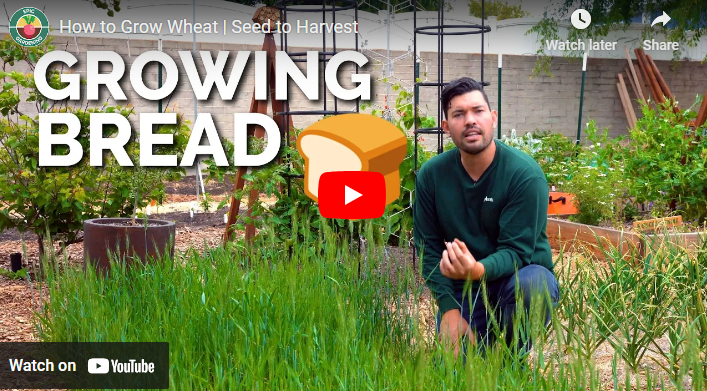Wheat is one of the most widely cultivated and consumed cereal crops in the world. Whether you’re a hobbyist gardener or a farmer looking to grow wheat on a larger scale, this step-by-step guide will provide you with the essential information you need to successfully grow wheat.
To grow wheat, prepare a well-drained soil with a pH level between 6 and 7, sow the seeds at a depth of 1-2 inches and keep the soil moist but not waterlogged until the plants mature and turn golden brown.
Before embarking on your wheat-growing journey, it’s crucial to understand the crop and its benefits. Wheat is a versatile grain rich in carbohydrates, fiber, vitamins, and minerals. It serves as a staple food for many cultures and plays a vital role in global food security.
How to Grow Wheat Step by Step Guide
Step 1: Choosing the Right Variety of Wheat
Selecting the appropriate wheat variety is essential for successful cultivation. Factors such as climate, soil type, and intended use of the wheat grains should be considered. Common wheat varieties include hard red winter, soft red winter, hard red spring, and durum. Research and consult local agricultural experts to determine the best variety for your region.
Step 2: Preparing the Soil
Proper soil preparation is crucial for healthy wheat growth. Begin by testing the soil pH and fertility levels. Wheat thrives in well-drained soil with a pH range of 6 to 7. Adjust the soil pH if necessary and incorporate organic matter to enhance soil structure and fertility.
Step 3: Planting the Wheat Seeds
Once the soil is ready, it’s time to plant the wheat seeds. Choose a suitable planting method based on your available resources and scale of farming. Whether you opt for traditional broadcasting or precision drilling, ensure that the seeds are sown at the correct depth and spacing to promote optimal germination and growth.
Step 4: Providing Adequate Water
Water is crucial for wheat’s growth and development, particularly during key stages such as germination, tillering, and grain filling. Monitor soil moisture levels and provide regular irrigation to keep the plants adequately hydrated. Avoid overwatering, as it can lead to waterlogging and adversely affect the crop.
Step 5: Applying Fertilizer and Nutrients
Wheat requires essential nutrients for healthy growth. Conduct a soil analysis to determine the nutrient deficiencies and apply fertilizers accordingly. Nitrogen, phosphorus, and potassium are the primary macronutrients required by wheat. Additionally, micronutrients like zinc and iron are also essential. Follow recommended application rates and timings to ensure proper nutrient uptake.
Step 6: Managing Weeds and Pests
Weeds and pests can significantly impact wheat yields. Implement effective weed management strategies such as pre-planting weed control, crop rotation, and post-emergence herbicide application. Monitor the crop regularly for pest infestations and employ appropriate integrated pest management techniques to minimize damage.
Step 7: Monitoring and Caring for Wheat Plants
Throughout the growing season, closely monitor the wheat plants for any signs of nutrient deficiencies, diseases, or other issues. Address these problems promptly through appropriate interventions such as foliar sprays, fungicides, or insecticides. Additionally, ensure proper ventilation and airflow to prevent the development of fungal diseases.
Step 8: Harvesting the Wheat
Harvesting is a crucial step in wheat farming. Monitor the crop for maturity indicators such as yellowing of leaves and hardening of grains. Time the harvest when the moisture content of the grains is around 13-14%. Use appropriate harvesting equipment, such as combine harvesters, to efficiently harvest the wheat and minimize losses.
Step 9: Storing and Processing the Wheat
After harvest, it’s essential to store the wheat properly to maintain its quality and prevent spoilage. Clean the grains to remove any impurities and store them in a cool, dry, and well-ventilated area. If you plan to process the wheat into flour or other products, ensure the grains are adequately cleaned and dried before milling.
Step 10: Troubleshooting Common Wheat Growing Issues
Wheat farming can face various challenges, including diseases, nutrient deficiencies, and adverse weather conditions. Learn to identify and address common issues such as rust, powdery mildew, lodging, and nutrient imbalances. Consult agricultural extension services or local experts for specific guidance based on your region.
Tips for Maximizing Wheat Yield
To achieve optimal yields, implement certain practices. These include timely planting, appropriate seed selection, optimal nutrient management, proper irrigation, effective weed control, and pest management. Additionally, crop rotation, soil conservation practices, and continuous learning about new farming techniques can contribute to improved yields.
Sustainable Wheat Farming Practices
As responsible farmers, it’s essential to prioritize sustainability in wheat farming. Implement practices such as conservation tillage, cover cropping, crop rotation, and integrated pest management to reduce environmental impact and promote long-term soil health. By adopting sustainable techniques, you can contribute to a more resilient and eco-friendly agricultural system.
Can wheat be grown in any climate?
Wheat can be grown in a range of climates, but it thrives in temperate regions with cool winters and mild summers.
How long does it take for wheat to mature?
The time it takes for wheat to mature can vary depending on the variety and growing conditions, but it typically ranges from 90 to 120 days.
Is wheat farming profitable?
Wheat farming can be profitable, but it depends on various factors such as yield, market prices, input costs, and management practices.
Can I grow wheat in my backyard garden?
Yes, you can grow wheat in a backyard garden if you have sufficient space and proper growing conditions.
What are some common pests that affect wheat?
Common wheat pests include aphids, armyworms, Hessian flies, and cereal leaf beetles. Implementing pest management strategies can help control their populations.
Conclusion
Growing wheat requires careful planning, knowledge, and continuous monitoring. By following this step-by-step guide, you can embark on a successful wheat farming journey. Remember to consider your specific growing conditions, adapt the recommendations accordingly, and always be open to learning and adapting your approach for the best results.




